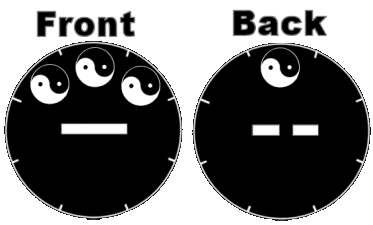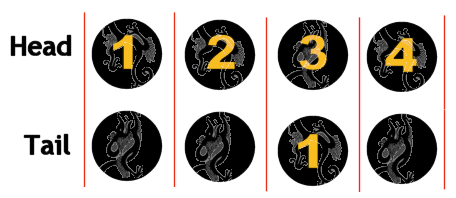5. Coins
5.1 Introduction
This section describe methods that use coins, the classical "three coins" method is described in section 3.
The simplest way of considering coins is as a two face dice. The traditional "three coins" method uses coins in this way, having assigned 2 to a face and 3 to the other.
For each coin you have two possible outcame, this means that with one coin you have 2 possible events: head and tail (h and t for brevity), with two coins 4 (hh,ht,th,tt), in general using n coins you will have 2n events.
If you consider only head and tail, it will be difficult to distinguish among similar states (for example hth or hht). You have different options:
- Use this fact. For example the "three coins" method considers the three outcome tth, tht and htt as identical.
- Stack the coins as they fall. The six coins method use this approach, you arbitrarily introduce and ordering in the coins.
- Use different coins. The ordering is predetermined as in the Xiao Guo/Jie method where is suggested to use three different coins and the following order: a penny, a nickel, and a dime.
Another way of viewing coins is as n-sided polygons with n arbitrarily high. The "one coin" method below uses this approach and groups these sides in eight groups (it also considers head and tail).
5.2 One coin*
- Materials
- One special coin marked as follows:

- Usage
- Flip the coin then chose one point in the border. Now look at the coin's face and draw the corresponding line. If the chosen point corresponds to a tao sign, then you have a moving line.
- Comment
- This method provides the same odds than the 16 marbles one.
Prob( ) = 1/2 * 1/8 = 0.0625
) = 1/2 * 1/8 = 0.0625
Prob( ) = 1/2 * 7/8 = 0.4375
) = 1/2 * 7/8 = 0.4375
Prob( ) = 1/2 * 5/8 = 0.3125
) = 1/2 * 5/8 = 0.3125
Prob( ) = 1/2 * 3/8 = 0.1875
) = 1/2 * 3/8 = 0.1875
Prob( or
or  ) =
1/2 = 0.5
) =
1/2 = 0.5
Prob( or
or  )
= 1/2 = 0.5
)
= 1/2 = 0.5
Prob( ->
->  ) = 1/8 = 0.125
) = 1/8 = 0.125
Prob( ->
->  ) = 3/8 = 0.375
) = 3/8 = 0.375
Would be nice to have a eight sided coin (UK has some seven side coins, but I'm not aware of any country having eight sided coins).
5.3 Two coins
- (copied from Clarity
)
Materials - Two identical coins.
- Usage
- Take your two coins, and throw them once. If both coins
come up heads, count this as 2; otherwise, count 3. Throw the coins
again. This time, each head counts 2, and each tail counts 3. Add the
total you receive here to the first figure.
Use the following table to draw the line:
6 7 8 9 



- Comment
- This method has a strong relationship with the
yarrow stalks one, not only the odds are the same, but the method
goes through equivalent steps. The first throwing is equivalent at the
first choice from 49 stalks: 2 has 1 chance out of 4 (0.25). In the
second throwing one coin represent the outcame of the second stalks
count while the other one represent the outcome of the third counting
from stalks, where 2 and 3 have the same odds (1/2).
Odds are the same as 1 coin method above.
- Variation
- You can use two pairs of coins (say two bronze and two iron) and throw them all togheter to cast the line at once.
5.4 Four coins*
- Materials
- 4 coins marked as follows:

- Usage
- Throw the four coins. If you can read 3 on one
coin, draw
 , otherwise
draw
, otherwise
draw  .
.
Sum face values, if the result is 8 or more it's a moving line ( or
or  )
)
- Comment
- The coin (3|1) will decide the type of line (
 or
or  ) with a 1/2
odd. The other three coins will generate a number between 0 and 7 with
a chance 1/8. These tables summarize the outcomes:
) with a 1/2
odd. The other three coins will generate a number between 0 and 7 with
a chance 1/8. These tables summarize the outcomes:
If 3 shows up:
3 4 5 6 7 8 9 10 







1/2*5/8
5/161/2*3/8
3/16
otherwise:
1 2 3 4 5 6 7 8 







1/2*7/8
7/161/2*1/8
1/16 - Variation
-
- You could use four different coins and assign different values
to each.
- You could also use four identical coins and stack them as they
fall using the following layout:
HEAD 1
2
3

4
0
0
1
0TAIL
- I've found another version of this method that's easy to remember
(see Mo
Lei-Li).
- Toss 1 coin:"Heads" = a yang (strong) line; "tails"
= a yin (weak) line. Leave the coin where you tossed it.
- Toss 3 more coins next to the first one. If you see exactly
3 heads among all 4 coins, then the line is changing; otherwise
unchanging. The following table shows why this method gives
the same odds as the 16 marble one.
Tttt 8 Thtt 8 Httt 7 Hhtt 7 Ttth 8 Thth 8 Htth 7 Hhth 9 Ttht 8 Thht 8 Htht 7 Hhht 9 Tthh 8 Thhh 6 Hthh 9 Hhhh 7
- Toss 1 coin:"Heads" = a yang (strong) line; "tails"
= a yin (weak) line. Leave the coin where you tossed it.
- You could use four different coins and assign different values
to each.
5.5 Six coins
- (copied from Mo
Lei-Li)
Material - Six coins of which 5 are the same and one different.
- Usage
- Throw the six coins at once and push them into a stack as
they fell. Heads =
 , tails =
, tails =  , the
different coin represents the moving line.
, the
different coin represents the moving line.
- Comment
- No chance of getting more than one moving line, or of getting
an unchanging hexagram. This method generates each hexagaram with a
probability of 1/64, exactly as the 3 coins or yarrow stalks methods.
Considering all the 4096 (4^6) possible outcome, this method restricts
to 384 (6*2^6) outcomes: there are 64 configurations when the changing
coin is the first one, 64 when is the second one and so on.
Prob( ) = 1/2 = 0.5
) = 1/2 = 0.5
Prob( ) = 1/2 = 0.5
) = 1/2 = 0.5
Using this methods there are only 6 equally probable relating hexagrams for each heaxagram.
5.6 Xiao Guo /Jie
(copied from Charles
Sorgie)
Charles Sorgie invented this method for casting hexagrams starting from
the hexagram number 62 (Xiao Guo) changing into 40 (Jie). It uses six
coin tosses (or two three coins tosses) for each line to determine the
nature of the line. The paper gives a full analysis of this method.
In essence it uses the six coins to generate a number between 0 and 63 and a lookup table to read the outcame for each throwing. Odds are very close to the "yarrow stalk" method:
| 0 - 2 | 3 - 16 | 17 - 34 | 35 - 63 |
| |
|
||
| 3/64 (0,046) |
14/64 (0,218) |
18/64 (0,281) |
29/64 (0,4531) |
5.7 Twelve coins
- thanks to Tom
Material - 12 coins.
- Usage
- A line can be determined by only two coins:
Tail/Tail Head/Head Head/Tail Tail/Head 



Cast six coins. Use both hands to push the coins into a column. If one coin is above the other, slide the topmost coin forward. This column represents the lower lines of the six bigrams.
Repeat with six more coins and push the two columns of coins together. The hexagram can be read off immediately.
- Comment
- These are the odds computed for this method:
Prob( )
= 1/4 = 0.25
)
= 1/4 = 0.25
Prob( ) = 1/4 = 0.25
) = 1/4 = 0.25
Prob( ) = 1/4 = 0.25
) = 1/4 = 0.25
Prob( ) = 1/4 = 0.25
) = 1/4 = 0.25
Prob( or
or  ) =
2/4 = 0.5
) =
2/4 = 0.5
Prob( or
or  )
= 2/4 = 0.5
)
= 2/4 = 0.5
Prob( ->
->  ) = 1/2 = 0.5
) = 1/2 = 0.5
Prob( ->
->  ) = 1/2 = 0.5
) = 1/2 = 0.5